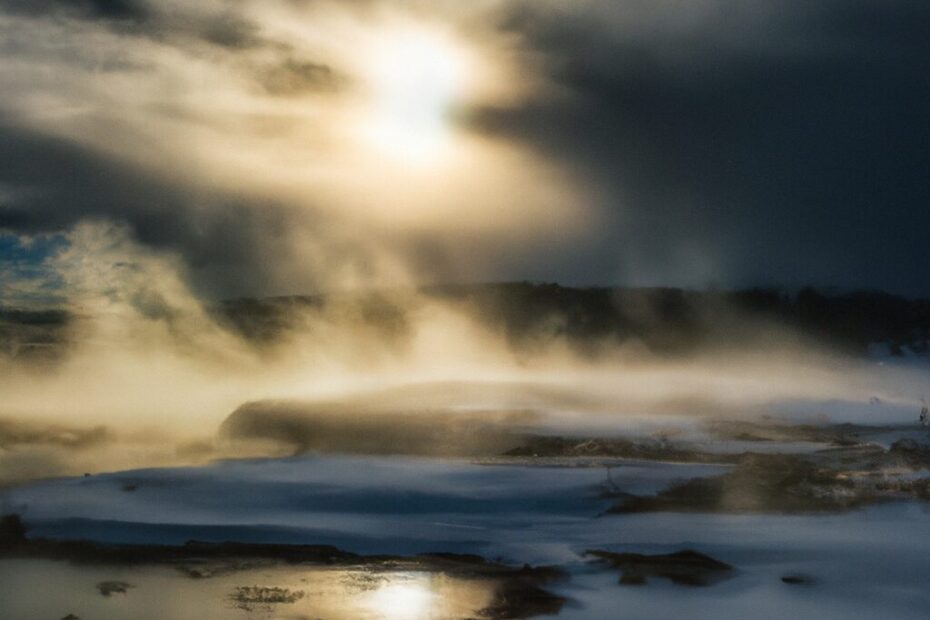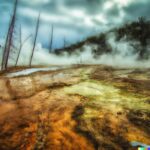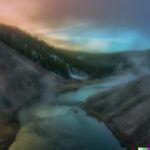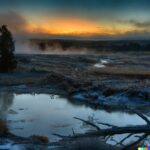Geysers are one of the most captivating natural wonders on Earth. Two of the most famous geysers in the world are Lion Geyser and Old Faithful.
In this article, we will explore the differences and similarities between these two remarkable geysers. We will cover everything from their location and eruption patterns to their size and surrounding landscape. Additionally, we will discuss which geyser is more impressive and the best times to see them erupt.
So, if you’re planning a trip to Yellowstone National Park, you won’t want to miss this insightful comparison.
What Are Geysers?
Geysers are natural hydrothermal features found in various geologically active regions, with Yellowstone National Park being a notable hotspot for these captivating phenomena.
Geysers are formed when underground water, heated by the Earth’s core, reaches temperatures well above the boiling point. Despite the intense heat, the water remains in a liquid state due to the immense pressure.
As the water is forced upwards through fractures in the Earth’s crust, it encounters cooler layers, causing it to rapidly boil and expand. This build-up of pressure eventually leads to the iconic eruption, shooting a combination of water and steam into the air.
The geological significance of geysers lies in their connection to the underlying geothermal activity. This provides insight into the Earth’s internal processes and the circulation of water and heat beneath the surface.
What Are The Differences Between Lion Geyser And Old Faithful?
When comparing Lion Geyser and Old Faithful in Yellowstone National Park, distinct differences emerge in their eruption patterns, temperatures, and overall geological significance.
Lion Geyser, with its irregular and unpredictable eruptions, offers a fascinating contrast to the famously consistent Old Faithful, which erupts approximately every 90 minutes, providing a reliable spectacle for visitors.
The temperature profiles of these geysers also vary, with Lion Geyser often reaching higher temperatures due to its more sporadic eruptions, while Old Faithful‘s frequent eruptions maintain a more steady temperature.
Their geological roles differ; Lion Geyser contributes to the ever-changing landscape of the park, while Old Faithful‘s regular eruptions have shaped the surrounding environment over time.
Location
Lion Geyser is situated in the Geyser Hill area of the Upper Geyser Basin in Yellowstone National Park. This area is known for its concentration of geysers and other geothermal features.
Lion Geyser’s location within the Geyser Hill area places it near numerous other geysers and hot springs, creating a vibrant geothermal landscape. As one of the prominent features in the area, it contributes to the natural beauty and diversity of the Yellowstone National Park.
Old Faithful is located in the Upper Geyser Basin, emphasizing its significance as a prime attraction within the geothermal region. Visitors can experience firsthand the captivating geothermal activity that defines this area of the park.
Eruption Pattern
The eruption pattern of Lion Geyser differs from that of Old Faithful, manifesting in varying intervals and duration, contributing to the diverse spectacle of geysers in Yellowstone National Park’s geothermal landscape.
Lion Geyser, with its irregular intervals and prolonged eruptions, adds an element of unpredictability to the geothermal features, creating unique opportunities for observation and study.
Conversely, the predictable eruptions of Old Faithful, occurring at regular intervals and lasting for a consistent duration, serve as a captivating display for visitors while also providing valuable insights into the behavior of geysers. Together, these distinct eruption patterns enrich the understanding and appreciation of the fascinating geothermal phenomena found in Yellowstone.
Size
In terms of size, Lion Geyser and Old Faithful exhibit differences in their physical dimensions, including variations in height and structural characteristics, shaping the geological formations of the geyser area in Yellowstone.
Lion Geyser, although not as famous as Old Faithful, stands at an impressive height of approximately 90 feet. Its unique cone shape and mesmerizing eruptions contribute to the diverse landscape of the geyser region.
On the other hand, Old Faithful is known for its predictability and reaches heights of around 184 feet, making it one of the tallest geysers in the park. These distinct features play a pivotal role in shaping the dynamic environment of the Yellowstone geyser area, captivating visitors with their natural wonders and geological significance.
Temperature
Lion Geyser and Old Faithful differ in their temperature profiles, influencing the surrounding hot springs and geothermal pools, each contributing distinct hydrothermal characteristics to the area.
This disparity in temperature plays a significant role in shaping the thermal dynamics of the region. The hotter water from Old Faithful infuses the adjacent hot springs and geothermal pools with higher temperatures, fostering the growth of thermophilic microorganisms capable of thriving in extreme heat.
In contrast, the cooler water from Lion Geyser imparts a different set of hydrothermal attributes, creating unique ecosystems and mineral formations in its vicinity. These temperature variations profoundly impact the geological and biological diversity of the surrounding landscape.
Surrounding Landscape
The surrounding landscapes of Lion Geyser and Old Faithful showcase the diverse manifestations of geothermal activity, contributing to the allure of Yellowstone National Park as a destination for natural wonders and tourist attractions.
These unique geological and geothermal features have played a significant role in shaping the park’s iconic landscape. The hydrothermal activity, including hot springs, geysers, and mud pots, has sculpted colorful terraces and basins.
Visitors are captivated by the dynamic and otherworldly scenes, with steam billowing from the geysers and the vibrant hues of the microbial mats. The geological forces at work beneath the surface continue to awe and inspire, providing a living showcase of Earth’s natural processes.
What Are The Similarities Between Lion Geyser And Old Faithful?
Despite their differences, Lion Geyser and Old Faithful share several similarities, including their location within the iconic Yellowstone National Park, their predictable eruption patterns, and their contributions to the geothermal features of the region.
Both the Lion Geyser and Old Faithful are situated in the Upper Geyser Basin of Yellowstone National Park, attracting visitors from around the world to witness their majestic eruptions. Their predictable eruption patterns make them reliable spectacles, and their role in shaping the geothermal landscape of the park cannot be overstated.
These iconic geysers symbolize the raw power and natural beauty that define the geothermal wonders of Yellowstone.
Both Are Located In Yellowstone National Park
Lion Geyser and Old Faithful share the distinction of being located within the captivating expanse of Yellowstone National Park, enriching the park’s appeal as a hub for tourist attractions and geological formations.
Both Old Faithful and Lion Geyser are iconic geothermal features that attract millions of visitors to Yellowstone National Park each year. Old Faithful, with its impressive regularity and grandeur, and Lion Geyser, with its vibrant and dynamic displays, offer a captivating glimpse into the park’s geothermal activity.
These geysers are a testament to the park’s volcanic history and play a crucial role in shaping the constantly evolving geology of Yellowstone. They are an essential part of the park’s unique landscape and natural wonders, adding to its overall allure.
Both Are Predictable Geysers
Lion Geyser and Old Faithful share the characteristic of predictability in their eruption patterns, adding to the captivating nature of geysers as a prominent geothermal phenomenon.
The consistent eruption intervals of Old Faithful and Lion Geyser have fascinated scientists and visitors alike. These geysers serve as a prime example of the mesmerizing predictability of natural geothermal phenomena.
Old Faithful erupts every 60 to 110 minutes, while Lion Geyser has a more sporadic yet still relatively reliable schedule. These consistent patterns not only highlight the geysers’ geological significance but also offer a mesmerizing spectacle for all who witness their majestic eruptions.
Both Have Been Active For Over 100 Years
Both Lion Geyser and Old Faithful have maintained their active status for over a century, contributing to the ongoing exploration and research of geysers within Yellowstone’s geothermal landscape.
The continuous activity of geothermal features in Yellowstone has provided scientists with valuable data, offering insights into their intricate mechanisms. This long-standing continuity has led to a deeper understanding of the geothermal dynamics in the park, allowing researchers to uncover underlying geological processes.
As key attractions for visitors, the sustained eruptions of Lion Geyser and Old Faithful have also played a significant role in raising public awareness about the importance of geothermal resources and their preservation for future generations.
Both Have Unique Eruption Patterns
While both Lion Geyser and Old Faithful follow predictable eruption patterns, they each exhibit unique characteristics that contribute to the diverse utilization of geothermal resources and power.
Lion Geyser, for instance, is known for its less frequent but more powerful eruptions, releasing bursts of steam and water that reach staggering heights. This makes it an attractive source for harnessing geothermal energy with high potential output.
On the other hand, Old Faithful‘s more frequent eruptions are less forceful but maintain a remarkable level of consistency, offering a reliable source for geothermal power generation. Understanding the distinct features of these geysers is crucial for effectively tapping into the rich geothermal resources they provide.
Which Geyser Is More Impressive?
The question of which geyser is more impressive, Lion Geyser or Old Faithful, is subjective and dependent on individual perspectives, as both geysers offer awe-inspiring spectacles and contribute to the allure of geothermal attractions within Yellowstone National Park.
Lion Geyser is a popular attraction in the park, renowned for its stunning eruptions and vivid hues. Its displays are unpredictable yet captivating, leaving visitors in awe.
In contrast, the iconic Old Faithful is known for its regular and consistent eruptions, making it a reliable and majestic display of nature’s forces. Both geysers showcase the impressive geothermal activity of the park, solidifying its reputation as a natural wonder and attracting countless visitors who seek the wonder of these ancient natural phenomena.
What Are The Best Times To See Lion Geyser And Old Faithful Erupt?
The best times to witness the eruptions of Lion Geyser and Old Faithful depend on various factors, including the time of day and the unique characteristics of each geyser, adding to the allure of experiencing these captivating geysers as part of the geothermal phenomenon.
Both Lion Geyser and Old Faithful have their distinct personalities when it comes to eruption patterns.
For instance, Old Faithful is known for its predictability, with eruptions occurring roughly every 60-110 minutes, making it a reliable spectacle for visitors.
On the other hand, Lion Geyser‘s eruptions are less frequent but more dramatic, shooting water up to 90 feet in the air.
Timing your visit to witness these geysers in action enhances the overall experience, dictating the awe-inspiring moments nature has to offer.
How To Get To Lion Geyser And Old Faithful?
Accessing Lion Geyser and Old Faithful within the remarkable landscapes of Yellowstone National Park involves utilizing designated paths and transportation methods to ensure sustainable energy practices and minimal impact on the geothermal exploration of the area.
By adhering to designated paths and using eco-friendly transportation options, visitors can respect the delicate geothermal ecosystems and minimize their carbon footprint during their exploration.
This commitment to sustainable practices not only preserves the natural beauty of the park but also supports the ongoing efforts towards environmentally responsible tourism.
Understanding the significance of preserving geothermal resources in their natural state empowers visitors to engage with the park in a conscientious and respectful manner.
Frequently Asked Questions
What is the difference between Lion Geyser and Old Faithful?
Both Lion Geyser and Old Faithful are geysers located in Yellowstone National Park. However, they have some key differences that set them apart. Lion Geyser is known for its occasional powerful eruptions, while Old Faithful is known for its consistent and predictable eruptions.
Which geyser is more active, Lion Geyser or Old Faithful?
Old Faithful is considered to be more active than Lion Geyser. Old Faithful erupts approximately 20 times a day, while Lion Geyser only erupts a few times a year.
Can you see both Lion Geyser and Old Faithful in one visit?
Yes, it is possible to see both Lion Geyser and Old Faithful in one visit to Yellowstone National Park. However, since Lion Geyser only erupts a few times a year, it may require some planning and luck to witness its eruption.
Which geyser has a longer eruption duration, Lion Geyser or Old Faithful?
Lion Geyser has a longer eruption duration than Old Faithful. Lion Geyser’s eruptions can last up to 40 minutes, while Old Faithful’s eruptions usually last around 3-4 minutes.
Are there any other differences between Lion Geyser and Old Faithful?
Aside from their eruption patterns and duration, there are a few other differences between Lion Geyser and Old Faithful. Lion Geyser is smaller in size and has a more circular shape compared to Old Faithful’s cone-shaped structure.
Which geyser is more popular among tourists, Lion Geyser or Old Faithful?
Old Faithful is more popular among tourists than Lion Geyser. This is due to its consistent eruptions and predictable schedule, making it easier for visitors to plan their visit to see it.
Last Updated on January 26, 2024 by Jon Waraas – Originally Posted: January 25, 2024

I’m Jon Waraas, and I’ve been navigating the online world since 2006. By day, I’m the proud owner of some eCommerce gems, and by night, I’m the voice behind the adventures on Waraas.Com.
My heart, however, belongs to the wild beauty of Yellowstone National Park. I’ve got a collection of websites dedicated to sharing the wonders of this natural masterpiece. Oh, and did I mention? I’m currently building my own cabin inside the ghost town of Gilmore, Idaho – a cabin with tales to tell!
When I’m not immersed in the digital realm, you’ll find me lacing up my boots for a good hike or setting up camp under the star-studded sky.




